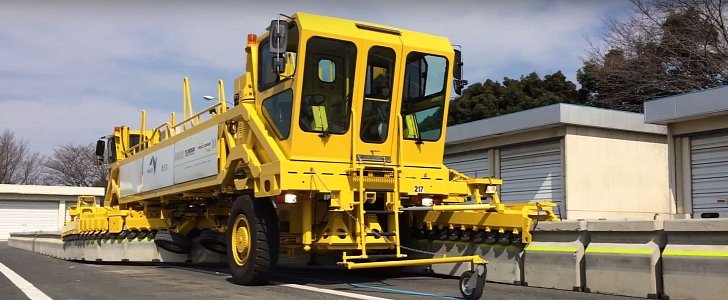Japan has one of the most advanced and dense road networks in the world. The upside is that you can move about freely, the downside being that it needs a lot of maintenance.
Despite strictly enforced speed restrictions and harsh fines, accidents do happen in the land of the rising sun. The barriers on the sides of highways are thankless heroes, as they stop crashing cars from killing people on the other side. What's more, they can be used to protect workers from the traffic.
One Japanese company called NEXCO has figured out a way to combine highway barriers with the stuff you use every time you go to the bathroom. Yeah, a zipper. The point is that all the not-so-little concrete blocks are joined with metal rods that give them articulation. They also have a bevel at the top so they can be moved, much like the links of the zipper.
By doing this, the barriers can be reset easily. They also come in handy if roadworks are necessary. A specially designed machine just comes along and moves everything to the next lane, keeping workers safe.
The machine works at 10 km/h and features numerous rollers that grab on the top of the zipper barrier. It can even operate autonomously, although for the first tests in East Japan form April to August, a man is behind the wheel.
The amazing machine makes it look so easy, but those concrete blocks are reinforced, measuring one meter in length. Each one weighs 700 kilograms or about the weight of an average kei car. The "road zipper" is made up of 54 of these things at a time, connected with steel pins that can also be replaced by the machine. At the ends, rubber blocks and water barriers are placed to dampen the collisions.
One Japanese company called NEXCO has figured out a way to combine highway barriers with the stuff you use every time you go to the bathroom. Yeah, a zipper. The point is that all the not-so-little concrete blocks are joined with metal rods that give them articulation. They also have a bevel at the top so they can be moved, much like the links of the zipper.
By doing this, the barriers can be reset easily. They also come in handy if roadworks are necessary. A specially designed machine just comes along and moves everything to the next lane, keeping workers safe.
The machine works at 10 km/h and features numerous rollers that grab on the top of the zipper barrier. It can even operate autonomously, although for the first tests in East Japan form April to August, a man is behind the wheel.
The amazing machine makes it look so easy, but those concrete blocks are reinforced, measuring one meter in length. Each one weighs 700 kilograms or about the weight of an average kei car. The "road zipper" is made up of 54 of these things at a time, connected with steel pins that can also be replaced by the machine. At the ends, rubber blocks and water barriers are placed to dampen the collisions.


